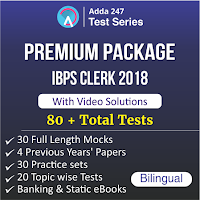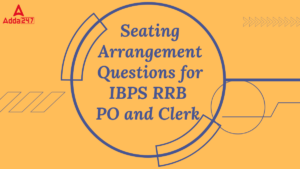Reasoning Ability is an onerous section. With the increasing complexity of questions, it becomes hard for one to give it the cold shoulder. The only way to make the grade in this particular section in the forthcoming banking exams like IBPS Clerk Prelims is to practice continuously with all your heart and soul. And, to let you practice with the best of the latest pattern questions, here is the Adda247 Reasoning Quiz based on the exact same pattern of questions that are being asked in the exams.
Watch Video Solution
Directions (1-5): Study the following alphanumeric series carefully and answer the questions given below:
9 6 5 @ K # F 3 $ 4 O % L * B 5 M 2 G T
Q1. How many letters are there between the elements which is 9th from both the ends?
Q2. Which among the following are the element which are eighth position from the left end and sixth position from the right end respectively?
Q3. How many symbols are immediately followed and preceded by numbers in the above series?
Q4. How many numbers are there which are immediately followed and preceded by numbers in the above series?
Q5. How many numbers are there which are immediately followed by symbol and immediately preceded letters?
Direction (6-10): In the following questions, the symbols @, $, ©, % and # are used with the following meanings as illustrated below:
‘A @ B’ means A is not greater than B
‘A % B’ means A is neither smaller than nor greater than B.
‘A © B’ means A is neither greater than not equal to B
‘A $ B’ means A is neither smaller than nor equal to B
‘A # B’ means A is not smaller than B
In each of the following questions, assuming the given statements to be true, find out which of the two conclusions I and II given below them is/are definitely true.
Q6. Statements: U # N © W @ R % D
Conclusions:
I. U # W
II. D # W
III. N © R
IV. U © D
II. D#W(TRUE)
III. N©R(TRUE)
IV. U©D(FALSE)
Q7. Statements: E © H, E @ L © P, B % H
Conclusions:
I. B © P
II. P $ E
III. H $ L
IV. E % B
II. P$E(TRUE)
III. H$L(FALSE)
IV. E%B(FALSE)
Q8. Statements: M © T # J $ K % Q
Conclusions:
I. T $ Q
II. J $ Q
III. T # K
IV. M © Q
II. J$Q(TRUE)
III. T#K(FALSE)
IV. M©Q(FALSE)
Q9. Statements: R © D # L @ M © P
Conclusions:
I. M $ R
II. D # P
III. L © P
IV. D % M
II. D#P(FALSE)
III. L©P(TRUE)
IV. D%M(FALSE)
Q10. Statements: W @ F $ M © D @ T
Conclusions:
I. F $ D
II. T $ W
III. M © W
IV. T $ M
II. T$W (FALSE)
III. M©W(FALSE)
IV. T$M(TRUE)
Directions (11-12): Study the following information carefully and answer the questions which follow–
‘S @ T’ means ‘S is father of T’
‘S % T’ means ‘S is son of T’
‘S # T’ means ‘S is wife of T’
‘S $ T’ means ‘S is mother of T’
‘S = T’ means ‘S is brother of T’
Q11. If expression ‘I % B # L and U # C @ L’ is true then how is C related to I?
Q12. If expression ‘B $ O = W @ L % R’ is true then how is L related to B?
Directions (13-15): Study the given information carefully and answer the given questions.
Among six people – A, B, C, D, E and F each of a different age, A is elder than only B. Only three people are younger than C. E is younger than F. F is not the eldest.
Q13. Who amongst the following is the youngest?
Q14. If E's age is 16 years, then which of the following may be B's age?
Q15. How many people are younger than E?






 GA Capsule for SBI Clerk Mains 2025, Dow...
GA Capsule for SBI Clerk Mains 2025, Dow...
 The Hindu Review October 2022: Download ...
The Hindu Review October 2022: Download ...
 Seating Arrangement Questions for IBPS R...
Seating Arrangement Questions for IBPS R...





